Chris Bogia is an artist, a professor and the co-founder of Fire Island Artist Residency (FIAR), an exclusive LGBTQ artists residency that takes place every summer in Cherry Grove, Fire Island. Currently in residence at the Queens Museum, the studio was surprisingly homey, as he had set up what he calls “a living room area,” including a desk for his laptop and a couch covered with Matisse’s leaves on one stretch of the studio, and in the other, a more traditional work area spread with unfinished sculptures that he was working on. In this L-shaped interior, he spoke to Jongho Lee about the evolution of his practice, current projects as well as hopeful future projects he had in mind.

Left: Artist Chris Bogia working at his desk in the “living room space” of studio with FIAR flag hanging above Right: The work space of Chris Bogia’s studio. Picture by Jongho Lee, 2017
The first thing that caught my eye were the watercolor drawings pinned on the studio wall, above his work desk and couch, throughout the work space. “These are all a part of the ‘Plants vs. Zombies’ series,” he explained, going through flat files of different drawings he’s made over the years. He landed on drawing as a medium about four years ago, when he stopped doing what he describes as “Installations that felt like abstractions of interior spaces.” These installations, which often included objects –some which he made and some which he got fabricated– album covers, and performative elements, existed in the end solely as photographs, some of which were exhibited at Kathleen Cullen Fine Arts in 2010.
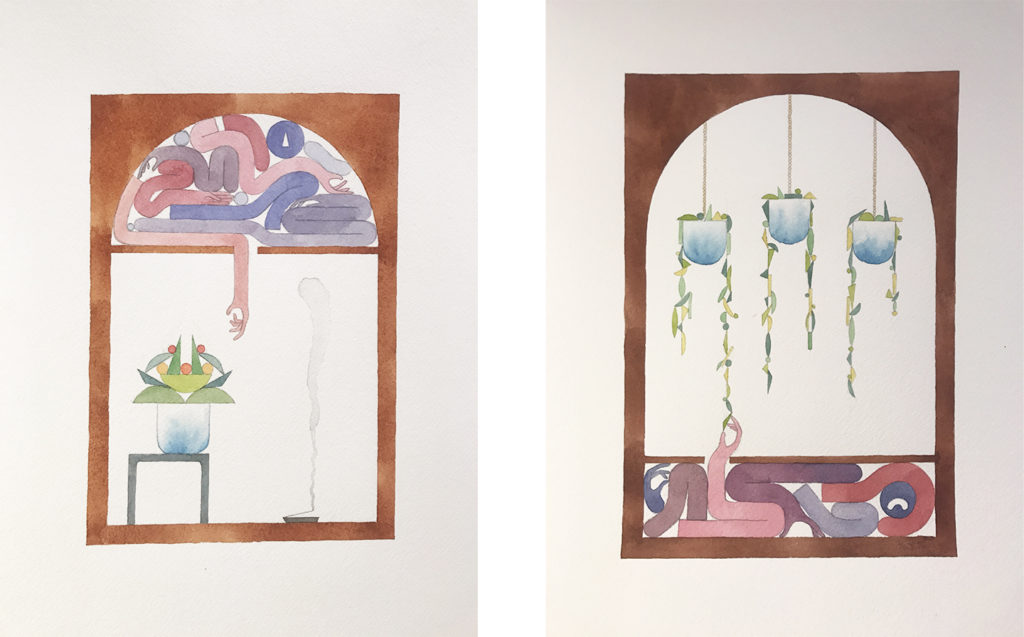
Two drawings from series “Zombies Vs. Flowers,” both 8.5 x 11 inches, watercolor and pencil on paper. Photos by Jongho Lee, 2017
The problem with this method of practice, he explained, were time restraints and the costs of fabrication and professional photography, especially when it came to elements like blown glass. The exhaustion of having to constantly work and keep track of different elements without seeing an end result was not something he could keep up with. Then came the drawings, where Chris fell in love with the ability to quickly execute one idea after another which yielded in a series of simple seductive drawings. Although the drawings are abstract, so much of Chris’s interests such as video and analog games, interior design, specifically 60’s decor which he grew up with and materiality. The latter is incorporated through later evolutions of the drawings, which manifested themselves through balance sculptures. At first, the sculptures started with just wood and yarn, as seen in pieces like “The Last Book,” (2014) and were hung on walls, later incorporating more of interior decorative materials, such as high-finished lacquers, veneers, and grasscloth wallpaper into the mix. In addition to these materials, the sculptures became more dimensional and came off the wall, with objects balancing in a frame that he builds out of MDF, then covers with veneer, as seen in “The Plant that Sold the World,” (2015). Chris describes these sculptures as “sculptures of paintings.”
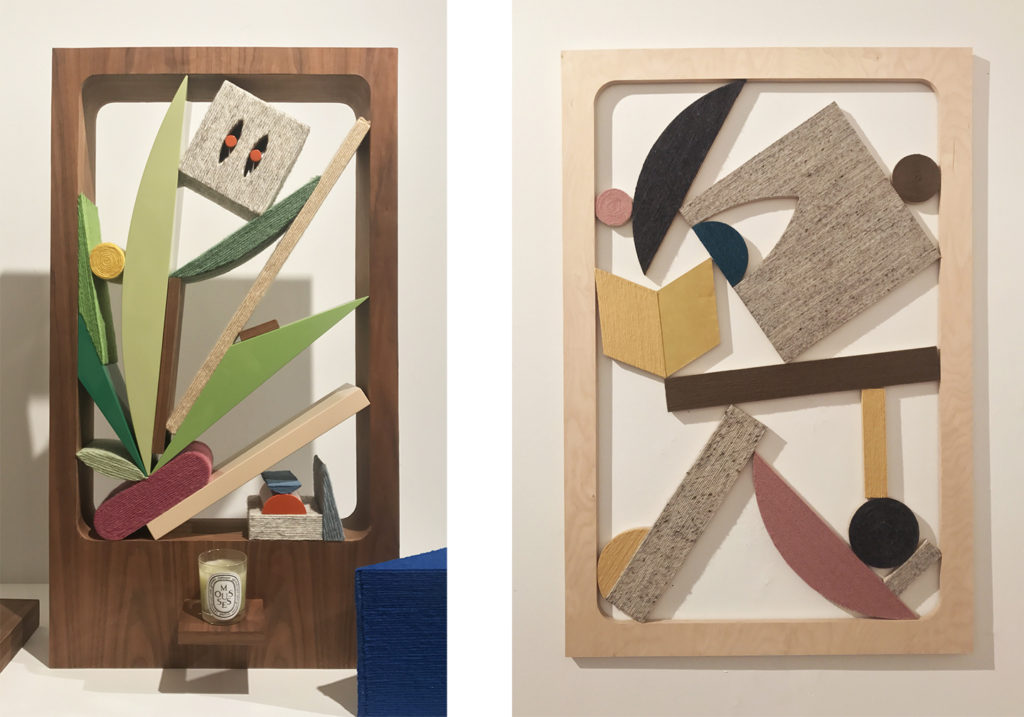
Left: “The Plant who Sold the World,” (2015) 2′ x 4′ x 5″, Right: “The Last Book,” 24″ x 16″ (2014) Picture by Jongho Lee, 2017
Even though certain drawings are precursors to the sculptures, they exist as separate artworks, rather than the drawings being a preparatory step for the sculptures. Chris explains that in order to visualize the colors he would use on the more recent freestanding sculptures, he uses markers to see the vibrancy of the colors that watercolor simply cannot execute. Expressing his discontent for the prevalent trend of muted colors in contemporary art, he describes his goal as reaching an abstract “Utopian Interior,” again referencing high-end interior design elements, and 60’s interior design. Instead of shying away from the interior decorative elements of his art, he embraces those exact elements and uses them as direct references.
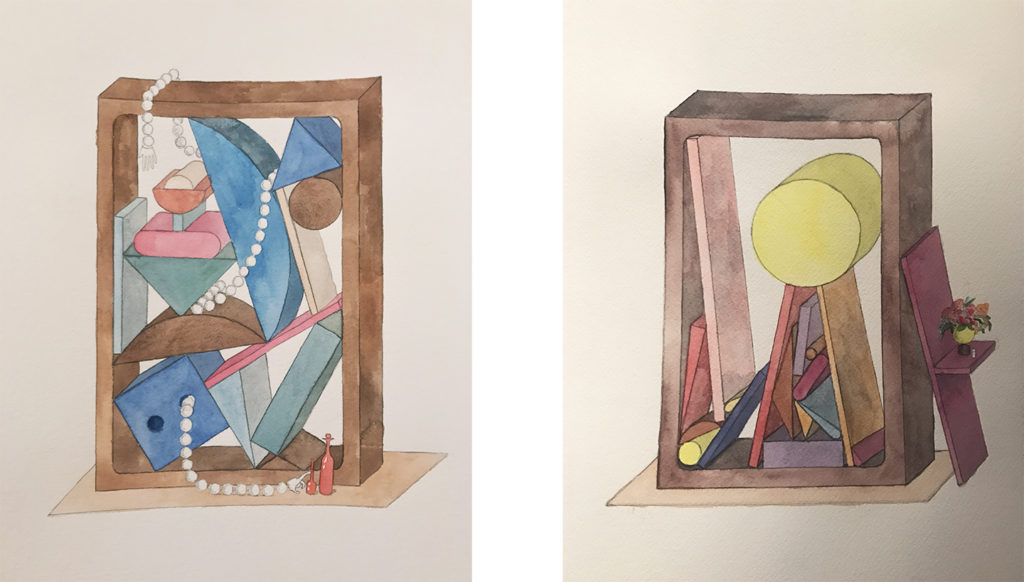
Left: “The Decorator,” 2016 Watercolor and pencil on paper Right: “Untitled,” 2016 Watercolor and pencil on paper. Both 8.5″ x 11″ Photo by Jongho Lee, 2017
Chris spoke of a personal struggle of coming to terms in engaging in such aesthetics and elements which may seem too indulgent in “high-end” decorations, especially during these politically turbulent times. The moment of realization came when he stopped seeing FIAR, the residency in which he is the co-founder, as work, but another part of his practice. Once he started seeing that the activism and community building taking place at the residency as just another branch of his practice, he was able to embrace the decorative elements needed to progress in his visual art making. He also talked about the importance of having a “living room area” in his studio for this very reason. When he first gets to the studio in the morning, he takes care of e-mails and other things regarding the residency, commenting that “…there is always work to be done year round, even though the actual residency takes place during the summer,” for a couple of hours before jumping into his own artwork.
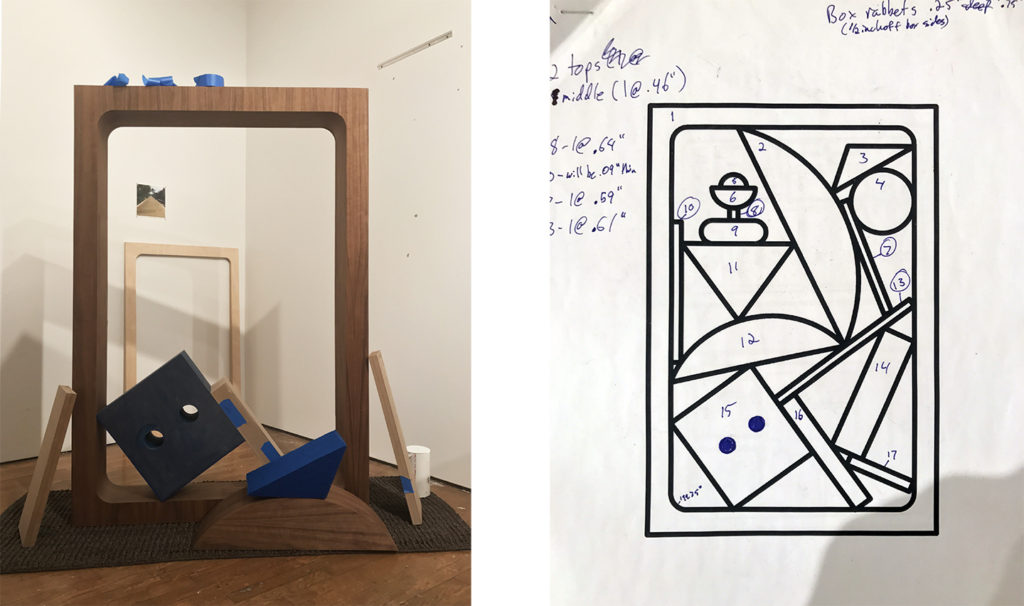
Left: “The Decorator,” work in progress Right: Sketch for “The Decorator” Photo by Jongho Lee, 2017
Currently, he is finishing the biggest balance sculpture that he has ever worked on; 6 feet tall, and 4 feet wide and 8 inches deep. It will be presented in an upcoming exhibition culminating in the 2015-2017 Studio Program Exhibition at the Queens Museum for the 9 artists involved in the program. The exhibition is critical for the completion of this piece, since he does not want to relive his past struggles of undertaking such a project without the prospect of showing it anytime soon. He has another sculpture the same scale in queue, pictured above. He talked about hopeful future projects, the most passionate one being a residency or a collaboration with Marimekko, a Scandinavian textiles company. He’d like to screen-print multiple editions one of his drawings, making a wall sculpture intended to hang on one long roll of fabric. The costs and labor of this would be astronomical, which was why it would be crucial to have a company like Marimekko on board, since they hand-print all their textiles in the first place, they already have an industrial set-up. Meanwhile, he plans to make a similarly scaled painting, just to see what it would look like on fabric. Most of his practice at while a graduate student at Yale involved large-scale, digital textile printing and the major difference would be that the prospective project would be exposed and screen-printed by hand, Chris commented “I spent most of my grad school career trying to force machines to do something that they weren’t meant to do. The result is the colors aren’t as vibrant and the whole print generally doesn’t come out as saturated as I wanted them to.”
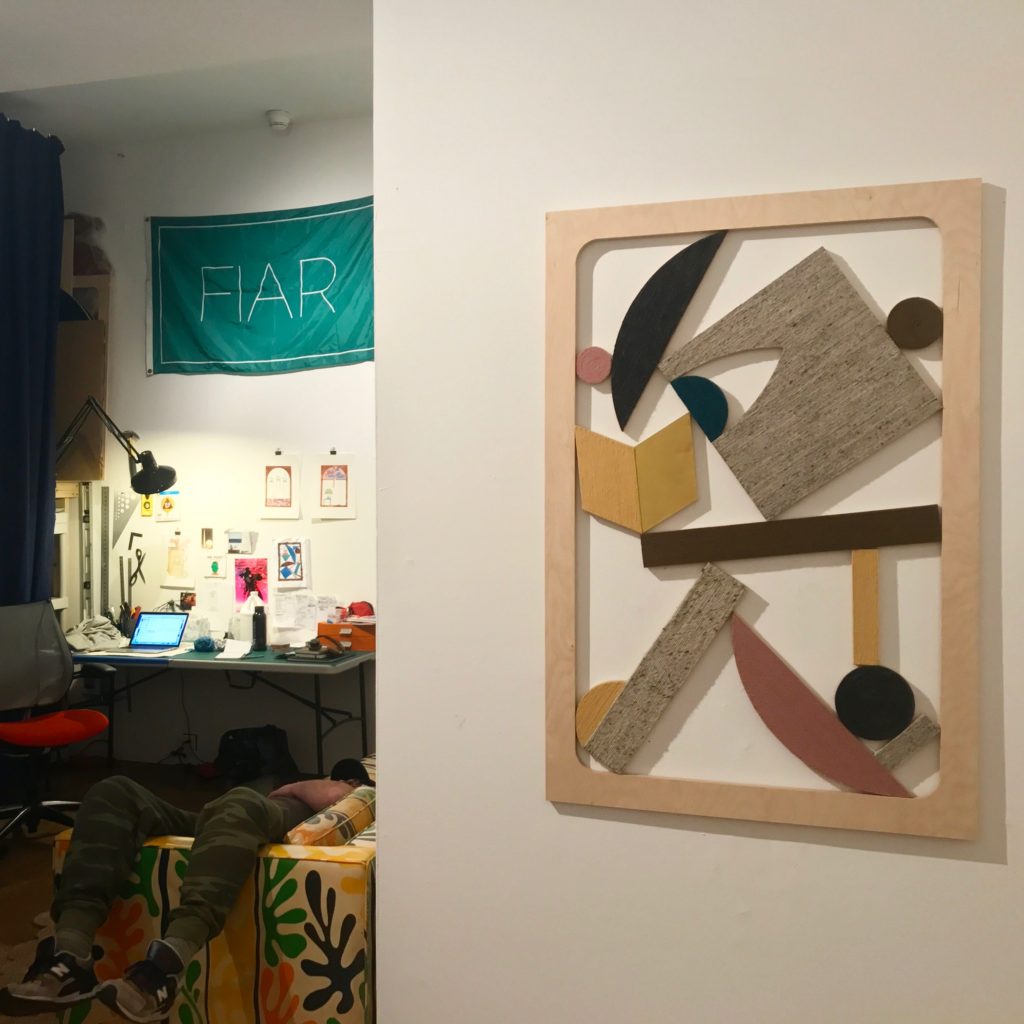
Artist Chris Bogia lying on his couch next to his sculpture, “The Next Book,” (2014)
“Steady Mess: Works from the 2016 Fire Island Artist Residency,” will be on view at the Bureau of General Services-Queer Division on 208 W 13th St, Rm 210 from February 3rd- March 27th, 2017. His exhibition at the Queens Museum will open in April 9th, 2017.
Jongho Lee is the Editorial Assistant for Eyes-Towards-The-Dove. He is an artist, writer, and a student at NYU’s Studio Art program at the Steinhardt School of Education in New York. He regularly contributes reviews, as well as studio visits to ETTD.
